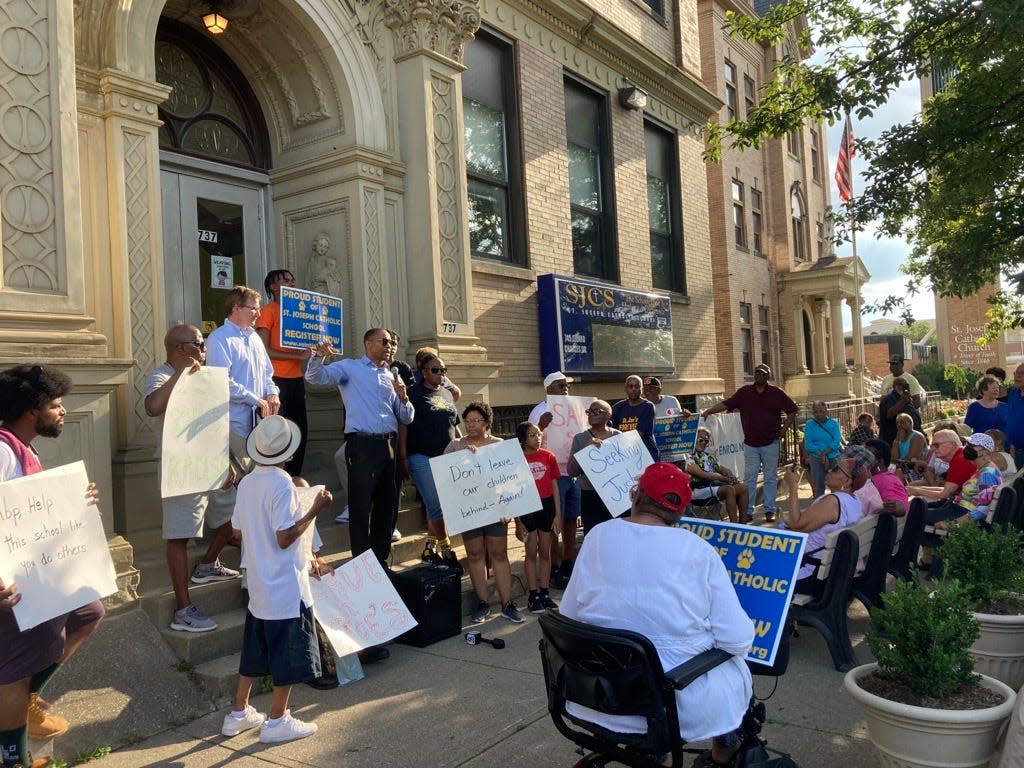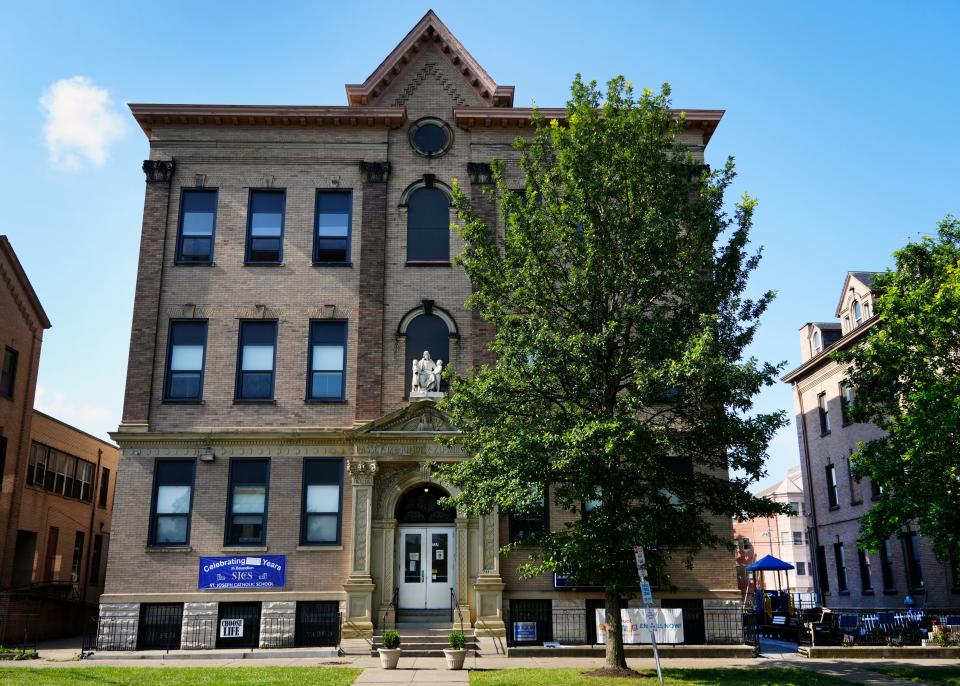Closure of St. Joseph Catholic School in the West End part of a national trend

- Oops!Something went wrong.Please try again later.
When she learned last month that St. Joseph Catholic School in the West End was closing after 176 years, Melba Marsh felt a rush of emotions. Sadness. Regret. Frustration that Cincinnati's church leaders hadn’t done more to save the school.
But she didn’t feel surprised.
“I had seen that coming,” she said.
Marsh, a Cincinnati judge, said she's known for years the odds of survival were against the school she’d loved since she was a student there a half century ago.
She’s watched urban Catholic schools like St. Joseph, with predominantly Black student populations, vanish from Cincinnati and other cities for more than a decade. At least a dozen of those schools, from Columbus to Kansas City, have shut down in the past year alone.
In Cincinnati’s West End, once home to as many as nine Catholic schools, St. Joseph’s was the last still in operation.
Schools in Black communities were a Catholic ministry
Like many of the closures, St. Joseph’s demise late last month set off a debate about the role of the church in America’s inner cities and its commitment to bringing Catholic education and ministry to Black communities that often have small Catholic populations.
Some parishioners and school alumni questioned the motives of the Archdiocese of Cincinnati, which declared St. Joseph’s school building a safety hazard in need of $2.5 million in repairs. Others, like Marsh, lamented the loss of a school that had long been a source of stability and inspiration to students like her.
The school nurtured her faith, Marsh said, but it also helped generations of Black students, many of them poor, take a first step toward better lives.
She said her small eighth grade class in the 1960s included at least one future doctor, two engineers and several lawyers, including herself. She’s not sure that would have happened without St. Joseph.
“The Catholic Church had a mission: We’re going to put Catholic schools into urban Black communities,” said Marsh, who is Black and a member of St. Joseph’s parish. “It’s so sad that the church is moving back from this mission, moving back from the Black community.”
Church leaders acknowledged the loss when they announced the school’s closure last week. “St. Joseph has been a rich and beautiful example of Catholic ministry during its long history,” said Susan Gibbons, superintendent of Catholic schools.
But they said the challenges and costs of maintaining a 125-year-old building were too great. Student enrollment had fallen 35% since 2017, from 262 to 168, and most of the $6,500-per-student cost of running the school every year came from taxpayers through Ohio’s Educational Choice Scholarship Program.
Few students at St. Joseph could pay full tuition without help, and the parish couldn’t afford to subsidize them. Unlike some Catholic parishes, fundraising and festivals would never be enough in the West End, where almost half the residents live in poverty.
It’s a familiar story in Catholic dioceses across the country. Predominantly Black schools often are in poor neighborhoods with limited resources while their buildings tend to be older and more costly to maintain.
Many of those schools have struggled for years, but the COVID-19 pandemic hit them especially hard. Black students make up 7% of Catholic school enrollment nationwide but accounted for 18% of students who lost their schools to closure between 2019 and 2021, according to the National Catholic Educational Association.
The association concluded the trend was a threat to the church’s historic mission to educate children, regardless of race or income.
“The erasure of Catholic schools from communities across the nation, particularly underserved communities, amounts to a disruptive divestment,” association officials wrote in a 2021 report. “It also has the added effect of decreasing the diversity of Catholic school communities.”
Historic mission becomes more challenging
In St. Joseph’s case, the challenges facing the school appear to have been complicated by disagreement between the archdiocese and St. Joseph’s former pastor, the Rev. Reynaldo Taylor, over how best to manage the school.
Taylor, who left St. Joseph in 2021 after 13 years as pastor, grew up in the West End and attended St. Joseph School. He didn’t dispute the financial difficulties facing the school, but he said closing predominantly Black schools here and elsewhere is an abandonment of the church’s historic mission in Black communities.
About 5% of the Catholic population in the United States is Black, and many of the Black students in Catholic schools, including St. Joseph School, are not Catholic.
“I think we’re dealing with a trend of a new form of racism in the country and the church,” said Taylor, who is one of about 250 Black priests in the United States. “We seem to have lost that sense of mission.”

When he agreed a few years ago to sign over control of St. Joseph School from the parish to the archdiocese, Taylor said he was so unhappy with the process that he left a note beneath his signature: “Get your knee off my neck.”
“I was a little bit tired of all the back-and-forth,” he said. “It was wearing on me.”
Jennifer Schack, an archdiocese spokeswoman, declined to comment on discussions between Taylor and church officials about the school, describing interactions with the priest as a personnel matter.
“Our focus right now is relocating children into new schools and staff into new employment,” she said. “That is going very well so far.”
Some parishioners and parish leaders share Taylor’s concerns about the archdiocese’s commitment to the school and are skeptical that the need for urgent repairs is the real reason St. Joseph won’t open this fall.
Lee Wilson, president of the St. Joseph parish council, said she worries church officials consider the school a bad investment because most of the students are poor, Black and non-Catholic. But she said the school was as valuable to the church as it was to the students.
“If you don’t have the kids in school, if you don’t engage with the families, you don’t have evangelization,” Wilson said.
She said most of the decline in enrollment occurred after the parish gave control of the school to the archdiocese, which worked with the nonprofit Catholic Inner-City Schools Education, or CISE, to financially support the school. A CISE spokeswoman referred questions to the archdiocese.
The nonprofit was formed to help the church carry out its mission in urban neighborhoods and continues to provide financial help to nine other Catholic elementary schools, where minorities, primarily Black and Hispanic students, make up 88% of enrollment.
“These Catholic schools would not exist without CISE,” the group says on its website.
'You're taking away something vital'
Still, the loss of St. Joseph School is a blow to the community. Of the more than 200 parishes in the Archdiocese of Cincinnati, four are predominantly Black. And until last week, the only one of those four to operate a parish school was St. Joseph.
LaVerne Summerlin, a University of Cincinnati English professor, attended Catholic schools while growing up in the West End and saw firsthand the impact they had on the students and the neighborhood.
Her experience made such an impression, she wrote a book about it: “Gems of Cincinnati’s West End: Black Children and Catholic Missionaries 1940-1970.”
All the schools she wrote about are now gone.
Many were lost when the city bulldozed the West End's Kenyon-Barr district in the 1950s to make way for I-75 and a new business district, forcing out 25,000 residents, most of them Black. Other predominantly Black schools, in the West End and elsewhere, have succumbed over the years to financial pressures and declining Catholic populations.
Summerlin thinks Catholics and their church should be doing more to save them, even if the costs are high because the students are poor. “Do I think that should be one of the church’s goals or missions? I do,” she said. “One of the ways to help people out of poverty is to educate them.”
Marsh, who went to law school and now is a Hamilton County Common Pleas judge, said she and her classmates are proof of the good those schools can do. Closing them, she said, hurts everyone, from the church to the community to the students.
“You’re taking away something vital,” she said. “You’re taking away one of the keys to success.”
This article has been updated to clarify CISE's role at St. Joseph, which is to provide financial support.
This article originally appeared on Cincinnati Enquirer: Why Black students are losing their Catholic schools

